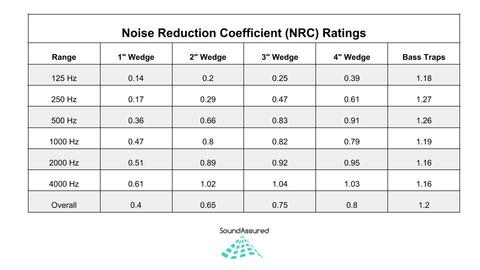Should I Add Acoustic Foam to my Home Theater
Listen, we get it. Money can be tight. You bought a massive display and now you realize that the coffers are a little dry. You need speakers, electronics, cables, and more. And now you read you need to add acoustic absorption to your walls? What the heck? You didn’t even know that was a thing! But, don’t worry! You found some acoustic foam tiles on Amazon for next to nothing. Surely I can put acoustic foam in my home theater and it will make a difference! I mean, acoustic is in the name! These should work…right?
The Different Types of Sound Absorption
When shopping for home theater absorption options, you’ll come across two main options. Insulation and acoustic foam. Insulation takes the form of rockwool or fiberglass. Acoustic foam is…well, foam. Those grey panels you see stuck to the wall in every movie that has a music studio. This stuff:

In comparison, the rigid fiberglass board looks like this:

Oftentimes, you’ll see the acoustic foam literally stuck to the wall. The rigid fiberglass board needs to be framed in some way, wrapped in fabric, and then hung like a picture. There are ways of treating the edges to firm them up but those products are much more expensive. If you are trying to save money, you will definitely DIY the fiberglass panels.
Cost-wise, the fiberglass absorption is much more expensive than the foam. It also requires more steps on your part and is harder to work with (fiberglass is never fun to handle). With acoustic foam, you take it out of the box, apply some double-sided tape, and you are done. But the real question is which works better.
Acoustic Foam vs. Fiberglass Absorption Effectiveness
If you read enough forum posts on the topic, you’ll see people say such things as acoustic foam “does almost nothing” or some such. Around here, we like data much more than parroted responses. So we decided to look up some numbers. First, BobGold.com (nope, we don’t know who he is) has a page that is nothing but fiberglass absorption coefficients. The way to read the page is that a 1.0 coefficient is 100% absorption. 0.8 is 80% absorption, etc. Measurements on acoustic foam are out there as well. This site lists coefficients for different thicknesses of foam.
When comparing the two (we are looking at the Owens Corning 703 with a 2″ thickness compared to the 2″ thick acoustic foam), they both perform pretty well above 1000Hz. The fiberglass is better as it absorbs everything from 1000Hz and up. The foam does okay absorbing about 80% or better from 1000Hz and up.

When we look below the 1000Hz mark, the acoustic foam drops off dramatically. At 500Hz it is absorbing 66%, and 250 it is down to 29%. Fiberglass, on the other hand, is still absorbing 86% or more at 250hz. That means that the fiberglass is absorbing significantly more bass than the foam. And bass is really what we want to absorb.

Further Reading: Gik (admittedly, they sell fiberglass absorption panels) did a test with measurements comparing acoustic foam to their panels. The results are similar to what we would expect from the measurements above.
Conclusion
Acoustic foam doesn’t work as well as fiberglass as an absorption option for your home theater. It does okay at the highest frequencies, but fails in the bass range. As bass is the problem we are trying to correct with absorption panels, foam just isn’t an effective solution. While it isn’t true that “acoustic foam does almost nothing” that some claim, it is true that it does almost nothing for the frequency range we care about.
Also, after typing “foam” so many times, the word now looks wrong. So there’s another reason not to buy it.


